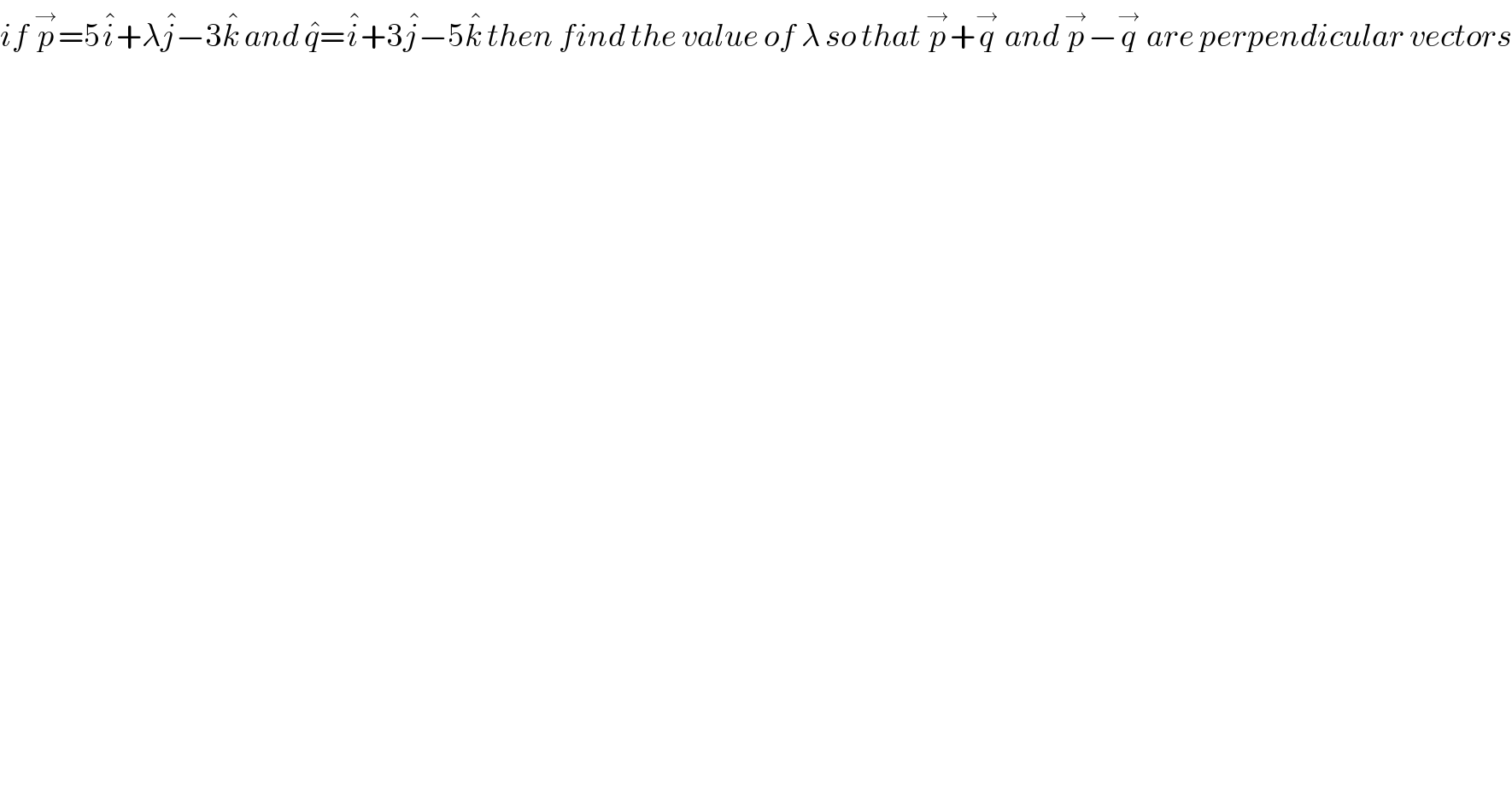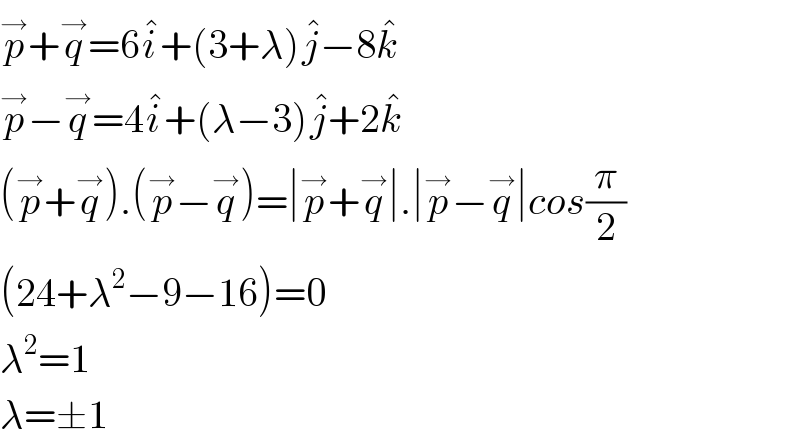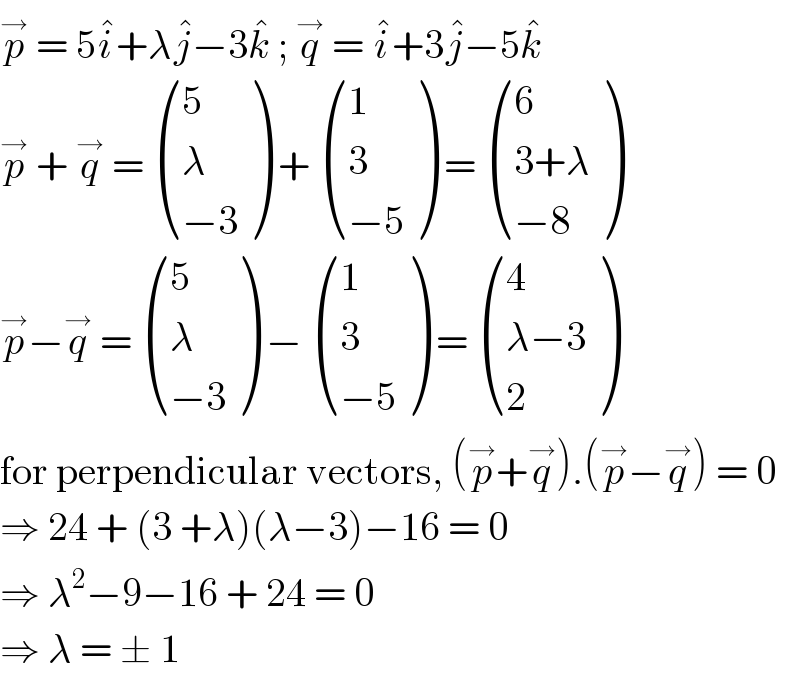
Question Number 118161 by gopikrishnan last updated on 15/Oct/20

$${if}\:\overset{\rightarrow} {{p}}=\mathrm{5}\hat {{i}}+\lambda\hat {{j}}−\mathrm{3}\hat {{k}}\:{and}\:\hat {{q}}=\hat {{i}}+\mathrm{3}\hat {{j}}−\mathrm{5}\hat {{k}}\:{then}\:{find}\:{the}\:{value}\:{of}\:\lambda\:{so}\:{that}\:\overset{\rightarrow} {{p}}+\overset{\rightarrow} {{q}}\:{and}\:\overset{\rightarrow} {{p}}−\overset{\rightarrow} {{q}}\:{are}\:{perpendicular}\:{vectors} \\ $$
Answered by Dwaipayan Shikari last updated on 15/Oct/20

$$\overset{\rightarrow} {{p}}+\overset{\rightarrow} {{q}}=\mathrm{6}\hat {{i}}+\left(\mathrm{3}+\lambda\right)\hat {{j}}−\mathrm{8}\hat {{k}} \\ $$$$\overset{\rightarrow} {{p}}−\overset{\rightarrow} {{q}}=\mathrm{4}\hat {{i}}+\left(\lambda−\mathrm{3}\right)\hat {{j}}+\mathrm{2}\hat {{k}} \\ $$$$\left(\overset{\rightarrow} {{p}}+\overset{\rightarrow} {{q}}\right).\left(\overset{\rightarrow} {{p}}−\overset{\rightarrow} {{q}}\right)=\mid\overset{\rightarrow} {{p}}+\overset{\rightarrow} {{q}}\mid.\mid\overset{\rightarrow} {{p}}−\overset{\rightarrow} {{q}}\mid{cos}\frac{\pi}{\mathrm{2}} \\ $$$$\left(\mathrm{24}+\lambda^{\mathrm{2}} −\mathrm{9}−\mathrm{16}\right)=\mathrm{0} \\ $$$$\lambda^{\mathrm{2}} =\mathrm{1} \\ $$$$\lambda=\pm\mathrm{1} \\ $$
Answered by Rio Michael last updated on 15/Oct/20

$$\overset{\rightarrow} {{p}}\:=\:\mathrm{5}\hat {{i}}+\lambda\hat {{j}}−\mathrm{3}\hat {{k}}\:;\:\overset{\rightarrow} {{q}}\:=\:\hat {{i}}+\mathrm{3}\hat {{j}}−\mathrm{5}\hat {{k}} \\ $$$$\overset{\rightarrow} {{p}}\:+\:\overset{\rightarrow} {{q}}\:=\:\begin{pmatrix}{\mathrm{5}}\\{\lambda}\\{−\mathrm{3}}\end{pmatrix}\:+\:\begin{pmatrix}{\mathrm{1}}\\{\mathrm{3}}\\{−\mathrm{5}}\end{pmatrix}\:=\:\begin{pmatrix}{\mathrm{6}}\\{\mathrm{3}+\lambda}\\{−\mathrm{8}}\end{pmatrix} \\ $$$$\overset{\rightarrow} {{p}}−\overset{\rightarrow} {{q}}\:=\:\begin{pmatrix}{\mathrm{5}}\\{\lambda}\\{−\mathrm{3}}\end{pmatrix}\:−\:\begin{pmatrix}{\mathrm{1}}\\{\mathrm{3}}\\{−\mathrm{5}}\end{pmatrix}\:=\:\begin{pmatrix}{\mathrm{4}}\\{\lambda−\mathrm{3}}\\{\mathrm{2}}\end{pmatrix} \\ $$$$\mathrm{for}\:\mathrm{perpendicular}\:\mathrm{vectors},\:\left(\overset{\rightarrow} {{p}}+\overset{\rightarrow} {{q}}\right).\left(\overset{\rightarrow} {{p}}−\overset{\rightarrow} {{q}}\right)\:=\:\mathrm{0} \\ $$$$\Rightarrow\:\mathrm{24}\:+\:\left(\mathrm{3}\:+\lambda\right)\left(\lambda−\mathrm{3}\right)−\mathrm{16}\:=\:\mathrm{0} \\ $$$$\Rightarrow\:\lambda^{\mathrm{2}} −\mathrm{9}−\mathrm{16}\:+\:\mathrm{24}\:=\:\mathrm{0} \\ $$$$\Rightarrow\:\lambda\:=\:\pm\:\mathrm{1}\: \\ $$
